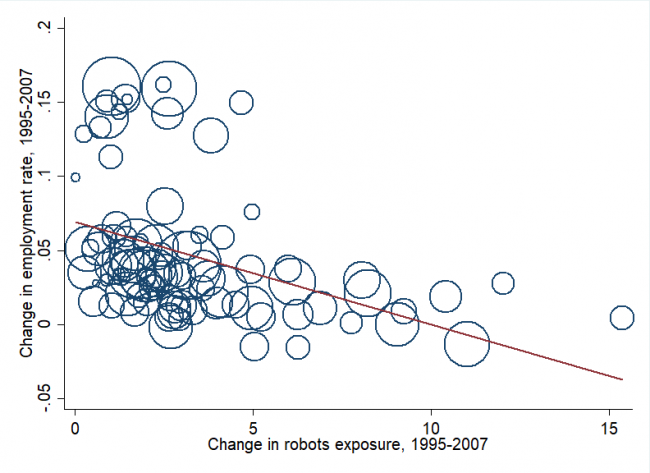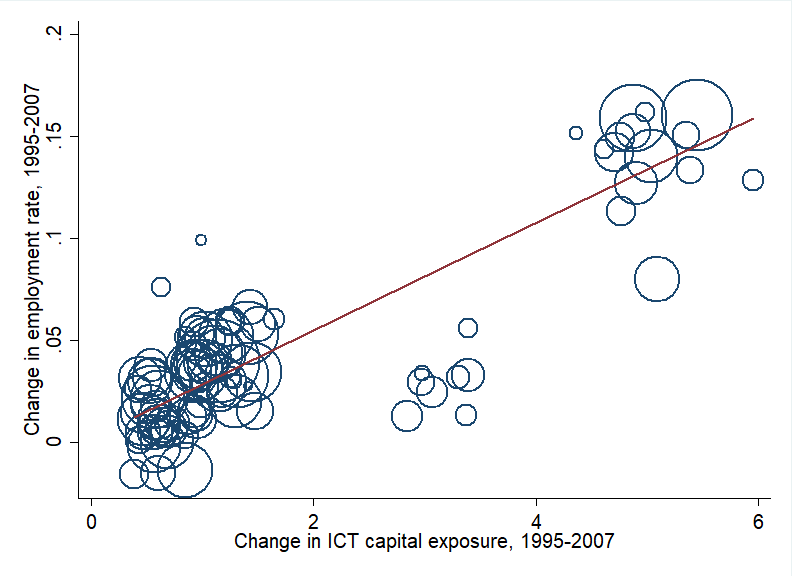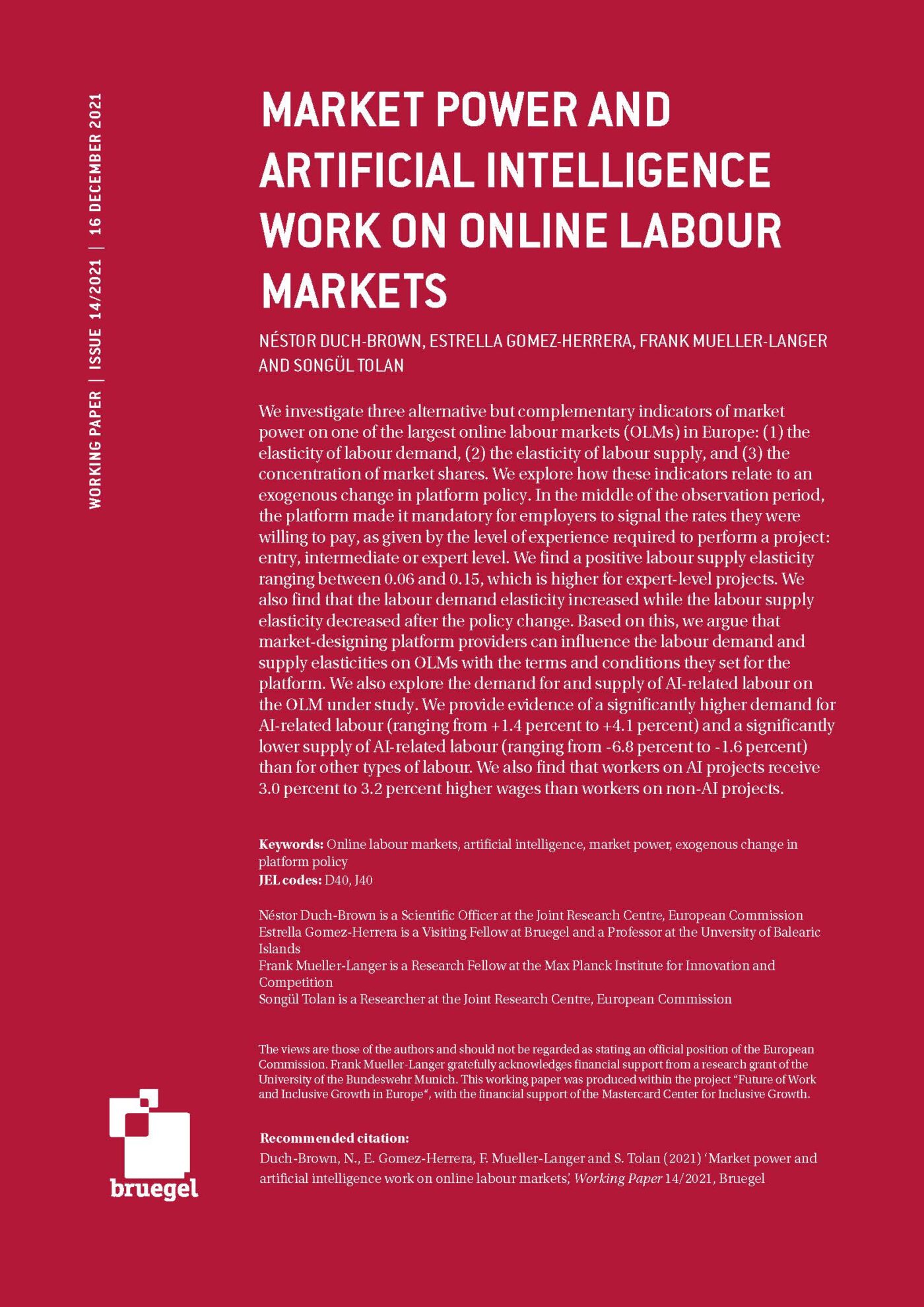Blog Post
Robots, ICT and EU employment
Disruptive technologies based on ICT, robots, and artificial intelligence have transformed labour markets through their important effects on employment. As the number of industrial robots continues to rise, our results imply that some measures to facilitate workforce transition and accommodate the rise of automation might be needed to maintain satisfactory labour market outcomes.
We are currently experiencing an unprecedented digital transformation, driven by rapid technological progress. Disruptive technologies based on ICT (Information and Communications Technology), robots and – more recently – artificial intelligence have transformed labour markets, with important implications for employment. In our recent working paper, we studied the impact of robots on employment between 1995 and 2007 in six European countries: Finland, France, Germany, Italy, Spain, and Sweden. In order to do so, we adopted the local market approach proposed by Acemoglu and Restrepo (2017).
We found that one additional industrial robot replaces 3.4 workers, on average. Our estimate is significantly lower than that of Acemoglu and Restrepo for US labour markets. Indeed, for the same period, they estimated that one additional robot replaces 6.2 workers[1].
Figure 1 presents the correlation between changes to the employment rate and the change in industrial robots per 1,000 workers of each region. The negative correlation is consistent with our main result mentioned above.
Figure 1. Change in exposure to robots and in employment rate (change in percentage points)

Source: Calculations based on Eurostat, EU Klems.
Note: Circles represent relative size (working age population) of each of the local labour markets considered.
In contrast, we found that the exposure of each region to ICT capital has a significant positive impact on employment rate. Figure 2 illustrates the positive correlation between the employment rate and ICT regional exposure from 1995 to 2007.
Figure 2. Change in ICT capital exposure and in employment rate (Change in percentage points)

Source: Calculations based on Eurostat, EU Klems.
Note: Circles represent relative size (working age population) of each of the local labour markets considered.
In theory, we can divide new technologies into two different categories:
1. Enabling technologies, which complement and increase the productivity of certain types of skills.
- For instance, laptops can increase the productivity of researchers or managers while software applications such as e-mail platforms can help increase the productivity of tasks which require coordination between agents in different locations.
2. Replacing technologies, which take over tasks previously performed by labour.
- Industrial robots – namely, automatically controlled, reprogrammable, and multipurpose machines which can perform several manual tasks (welding, painting, assembling, handling materials, packing, etc.) – belong to this category.
Replacing technologies can have two opposite effects: On the one hand, they directly displace workers (displacement effect). On the other hand, they increase the demand for labour in industries which surface or develop as a result of technological progress (productivity effect).
A natural question that arises is: Which of these two effects dominates? Focusing on the industrial robot – one of the main automated technologies in our study – we conclude that the displacement effect takes precedence.
The fact that ICT capital has a positive impact reveals that different technologies affect employment through different mechanisms. For example, ICT incorporates enabling technologies where we only observe the productivity effect. However, ICT can also refer to replacing technologies. In this case, the productivity effect seems to dominate the displacement of workers overall. We leave it to future research to analyse and compare in a more detailed fashion the impact of different technologies on the workforce.
The difference in the estimated impact of robots on employment between the EU and the US is an interesting finding that requires further investigation. There are many potential explanations for this: from their different economic fundamentals, to the fact that the EU is the front-runner in the adoption of industrial robots and, therefore, robotisation is more mature than in the US. Exploring the impact of welfare systems and labour market protection policies on the relationship between robots and employment rates remains an interesting avenue to explore.
As the number of industrial robots continues to rise, our results imply that some measures to facilitate workforce transition and accommodate the rise of automation might be needed to maintain satisfactory labour market outcomes. In any case, the extent to which displacement induced by automation progresses will greatly depend on economic growth and an increase in demand for all kinds of inputs (including labour) – thus preserving some jobs.
[1] It should be noted that the actual aggregate replacement effect is likely to be different since the numbers presented do not consider trade effects between regions.
Republishing and referencing
Bruegel considers itself a public good and takes no institutional standpoint. Anyone is free to republish and/or quote this post without prior consent. Please provide a full reference, clearly stating Bruegel and the relevant author as the source, and include a prominent hyperlink to the original post.








